Editor’s Note: This article was gladly contributed by one of our readers. Mark Sharp got his Commercial Pilot’s License at 18, his Airline Transport Pilot License at 23 and became at Delta Airlines Pilot at 24 where he worked for 33 years, retiring as a Captain on the Lockheed TryStar-L1011 in 1996.
This has been a 60-year program of trial and error which began on the family farm when I began flying for Delta in 1962.
An Oxygen tank and Nitrogen tank are necessary in our home and are used regularly. I get the tanks filled at my local welding gas supply. I was asked by my doctor if the O2 and N are medical grade? You just have to add ONE filter ($1.00) and you won’t be able to spot the difference. The Gas distributor told me this.
Oxygen keeps us alive and is the single most important thing for us to live. Oxygen also Oxidizes everything including metals. No bugs that attack food can live without O2. By replacing Oxygen or Air in a container with Nitrogen(N) you eliminate bugs. All grains and other foods must be DRY in the Nitrogen atmosphere to be stable and last for many years.
Freeze Dried food can last for 25-30 years in sealed containers and it maintains its taste, consistent color and is easy to use.
Dehydrated food taste is somewhat different, chewier and will only last 1-5 years, unless stored in Nitrogen.
Freeze Dried has 98% of the moisture removed and dehydrated food only about 75%, but a freeze dry machine is very expensive.
Our dry grains in nitrogen have lasted for over 40 years. Freeze dried is better in my view, but Dehydrated foods stored in buckets, in nitrogen gas, will last about as long, in our experience. I have learned to enjoy our grains. If you are hungry, even after 40 years, the taste is great.
We have grains that are over 40 years old still in the containers we used in the 60’s. It’s fun to see how long it takes to re-hydrate them. All have good taste and smell about the same as fresh.
I began offering free Nitrogen for containers in 1999, Y2K scare, in our home area here in western NC. What a great area! Self-sufficient families, using wood, coal and organic gardening, happy people, with a deep spiritual foundation. Some folks, with large families and co-ops have 55 gal containers full of grain, all, I filled with Nitrogen. Quick and easy and 16 years later they are still using out of the large containers.
Related: The Best Places in America to Be in The Event of a Collapse
The use of Nitrogen to displace Oxygen in food containers is very easy. When a food container is filled with the food it has AIR all around and if any bugs are on any of the particles of food they will live because they can breathe. If we eliminate the AIR by displacing it with Nitrogen gas, via a tube put to the bottom of the container and slowly start the nitrogen filling from the bottom, it will displace the Oxygen because it is heavier than the AIR.
We put a piece of foil with a candle in the middle, on top of the food in the bucket, and continue to fill the container, no matter what size, until the flame goes out. It does so because a fire will not continue in a Nitrogen atmosphere. I continue to fill for a short time to completely fill the container, then hammer the lid on and store. In over 40 years we have never seen a bug in a container when opened.
We refill occasionally with gas if we feel that we may have dumped some of the Nitrogen out when taking some of the grains out for cooking. There are many dehydrators out there for drying your fresh foods. My wife has about 10 trays and the kitchen has the smell of whatever you are drying.
Related: What Should You Do With Your Canned Foods After the Expiration Date?
Below I show the hose with the attaching fill valve from the Nitrogen tank, the candle on top of the grain, the containers we use daily in our pantry and our storage of our favorite foods we keep in the basement. This is not rocket science and using this method for, long term storage, is safe and effective, and easy. We also continue to rotate all our foods and it will last many years with our present storage. Our old containers are kept just to see how long they will last, we eat some every now and then, still good. 50 years and counting. Remember the grains found in the Egyptian tombs, some still sprouted after 4 thousand years, in a no Oxygen atmosphere. We consider a 2 year supply minimum for everyday use. Times are getting scary. A food supply is comforting. Like some silver and gold and my 357 magnum.
This has always been fun and important for our family. Not very long ago most of Europe was starving. (WW2) Today, some South-American countries are having a hard time with little or no food available. It is getting serious. Without trucking NYC goes hungry in 3 days.
The first pictures are of my O2 tank; my N tank is being refilled.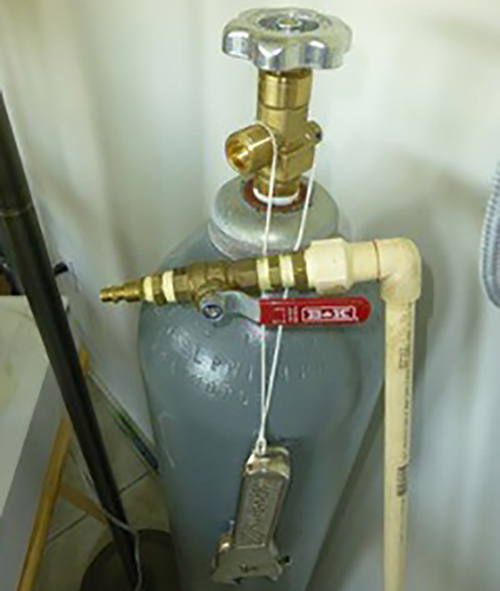
Here you can see the bottom of the 1/2“ tube with small holes for gas to escape into the containers. At the bottom of the tube I put a cap to keep the tube clear and provide constant flow of the N.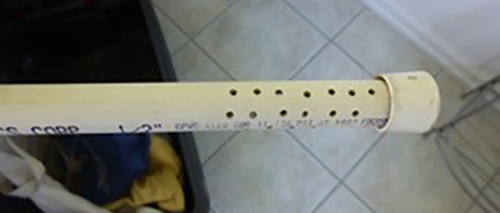
The 3rd is of the hose I attach the tube to the tank, you need the flexible hose to reach around the fill area.

Next is the fill tube down in the bottom of bucket of Oats The tubes long enough to accommodate 55 gal containers to reach the bottom.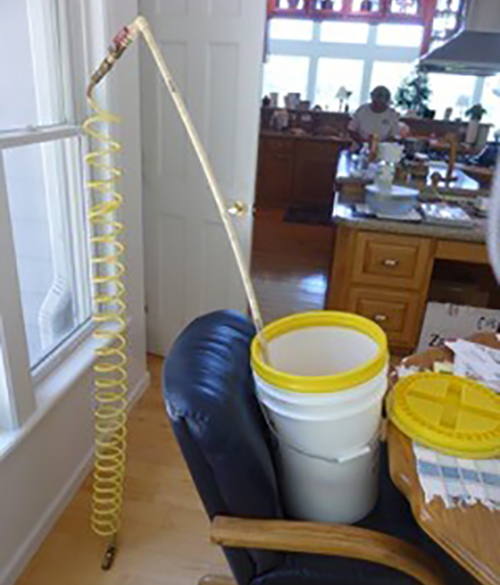
The tops shown are great and easy unscrew to get to the grains easy.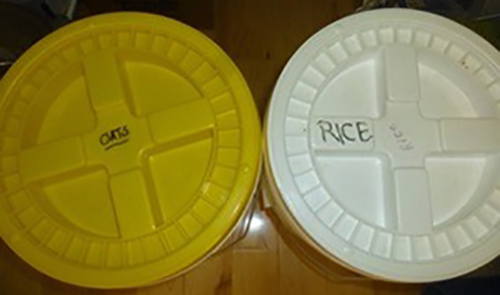
Ha, the 1999 date on the Oats (Y2K).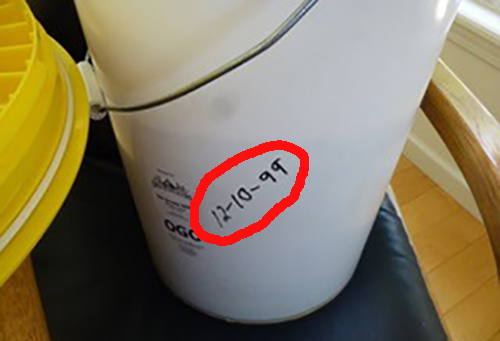
Our basement storage. 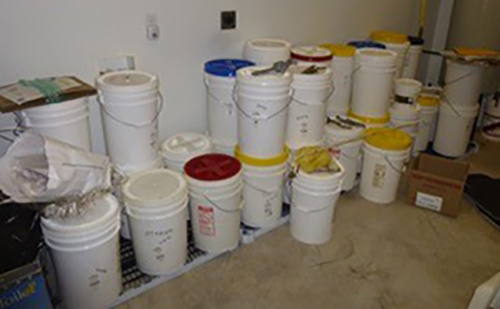
Our kitchen pantry containers use daily.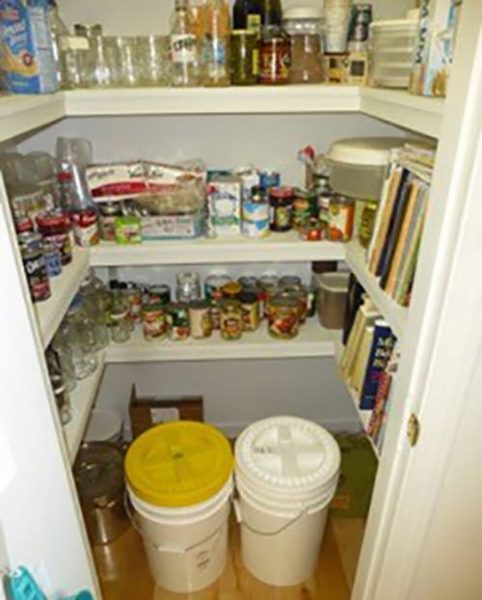
The candle I made from local clay.
You may also like:
20 Foods that Will Outlast You
An insanely effective way to build a 5 year stock-pile (Video)
12 Woodworking Projects for Preppers and Homesteaders
Preserving Potatoes Year Round; A Solid Choice for Preppers
7 Primitive Cooking Methods You Still Need to Know Today
Marc Sharp was a student pilot at 16, commercial pilot at 18, airline transport pilot at 23 and Delta Airline Pilot at 24… 33 years with Delta retiring as a Captain on the Lockheed TryStar-L1011 in 1996.
He says: “My Life Dream was attained in 1969 when I checked out as a Captain on Delta’s CV-440. The same airplane I watched land at my home airport where I was working while attending high school in Baton Rouge, LA in 1953.”

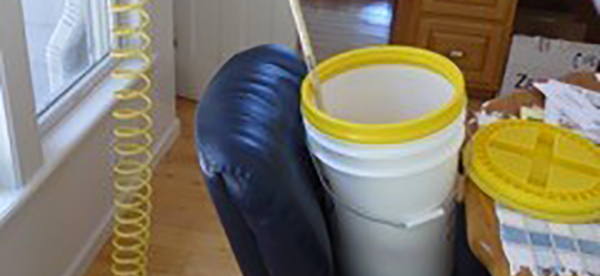










No mention of a regulator for the bottle…High pressure could be exciting through that little plastic hose.
What about oxygen absorbing tablets?
sure wish I could get a couple of videos to show and explain it all for. Is there any?
I don’t use a regulator . I just open the valve just a crack, a little more if a 55 gal container.–No problem The flame going out is the key for us and the N is easy out of the tank and the refills are just down the road.——–I’ll try to do a video, My grand son would like this as a project.—good questions guys—
the easy, least expense, and able to do large volume containers and KNOW how much N is in them. It’s easy————————Marc
sharp
O2 tablets, haven’t tried them but how can you tell what the remaining air is N. The N is what we wanted to kill the bugs and could tell if the container is full, the candle goes out
Thanks for the information! What type of filter do you use? I am hoping I can set up a similar system.
Our atmosphere is 78% nitrogen, 21% oxygen and 1% argon and other gases. O2 tabs will only absorb a small amount of oxygen in a sealed container, as oxygen is absorbed the resulting vacuum will stop continued absorption. Also N2 is lighter than O2 therefore N2 is also lighter than air.
Although a regulator works, a combination regulator / flowmeter would be the easuest to control and would regulate the flow of nitrogen to a few cubic feet per hour saving a considerable amount of gas.
The fliwmeter should be for inert gas
Thanks for the info. It’s very helpful. I have a tank of N ordered and a Nitrogen only regulator on hold. Mylar bags at the ready….
I’m wondering if the N makes rice, wheat etc harder to cook? Does it make cooking time longer? Also, after filling a bucket do u let it sit a while to b sure all the O2 floats up and out, then top off with more N???
Thanks!
Another way that we have been doing it is to put a chunk of dry ice in the bottom of a 5 gallon bucked. It works on the same principal as the nitrogen in that the CO2 that is released from the dry ice as it “melts” is heavier than air and it pushes the air out the top of the bucket. We place the dry ice (use gloves or tongs with rubber handles) between two small pieces of parchment paper and then put that in the bottom of the bucket. Pour the grain in on top of it. Put the lid (one that has a rubber gasket in it) on the bucket but don’t seal down one edge. The lids will bulge as the CO2 starts to accumulate and you will need to “burp” the lids. I never thought of using a candle to check the level of O2 in the bucket but they can’t burn when surrounded by CO2 either so I imagine that it would work for this technique too. There’s not a lot of room in a 5 gallon bucket for a candle though so maybe you could use one of those long nose fire lighters?
I used a coffee can with dry ice in it and a hose in the lid. The other end of the hose went to the bottom of the jars (that’s what I used). I used a tea candle on top. When the candle went out, I took it and the hose out and sealed the jars. Then repeated in on the next one. No need to burp using this method and you can get more use out of the dry ice.
I like the idea of using nitrogen tanks. Being on a budget, it’s hard to buy enough grains, rice, etc to justify the expensive dry ice. With a tank, you could use what you need and save the rest until you need it again.
Question: With one of the larger bottles, about how many five (5) gallon buckets would one be able to fill with nitrogen? That, of course, would be filled with grain, or beans, etc.
Up into several hundreds.
Hi guy. Good info! I have tried the five gal. buckets with mylar bags and oxygen absorbing tablets storing organic oats. I have opened the buckets 4 years later and the oats are fresh as the first day! 5 gal. bucket of oats are good for four People and can last 2 months straight eating as breakfast per bucket! Remember people that surviving also deals with replanting crops after it is safe to go back outside. Do not only rely on stored food because it will soon finish and if you have not taken the time to replant, you will soon suffer for the lack of farming. “But I don’t have any land?” You might say. People listen! Public land does not belong to the Government. It belongs to the Public. And who is the Public you might say? The Public is the People! Yes the land belongs to YOU! So go out there and OCCUPY the land that belongs to you. Start growing your survival food. Besides many people even some govt. officials don’t know the difference between a lettuce plant or a bee hive and they won’t notice.
Bonjour maitre jedi,
Déjà essayé! j’ai planté des graines dans des endroits libres comme les clairières, les chemins, certains coins inoccupés. Un désastre, les promeneurs marchent sur les pousses, les animaux domestiques font leur excréments dessus, et je ne parle même pas des sangliers ou animaux sauvages (chevreuil, lapin), auquel vient s’ajouter les incendies et l’eau de mer versé par les canadairs remplie de retardant. Non franchement très mauvaise idée, du moins en France!
Amicalement
Jean-Mi
Thanks for the great info. Also questions and answers
I’m not very mechanical inclined, but would like to learn exactly how to preserve food. Do you have step by step instruction for someone with my limitations?
Great article! My father retired from an industrial gas company and I’m sure he still has some connections. I might be able to pick up a tank or two. He still gets a tank of helium from his buddies every year. Growing up we never wanted for balloons!! lol I realize this might be a silly question, but is the O2 strictly for emergency medical use?
Chain up that N2 tank, ou don’t want it to take off like an L-1011.
What about the filter? What does it look like or can you post more info on it?
Where do you put the filter?
Any information please
we found a cash of 5 gal buckets in a root celar. unknown grain, nitrogen protected, Hanna Mills, of Ohio 8/87 on side
can you shed any light on these?
How do you get the candle and the pipe that you put in the 50 gallon bucket out without losing the nitrogen. Wouldn’t you have to open the top and once you did that it would release everything. Thanks
Nitrogen is heavier than air and if you take off the lid gently, it will stay in there.
If anyone uses this method a strict warning should go with it. Just as nitrogen kills bugs, it can kill people. It does not take a complete replacement of oxygen in a small room to kill. Air is 21% oxygen and for the most part the remainder is nitrogen. It takes 19 % oxygen in air to sustain human life. So, be sure and stay with your work. If you leave the room with your purge going on, you could return to a room full of nitrogen. If that were to happen you would pass out immediately and your brain would die within seconds. I have personally witnessed this where the person who walked in died and the person who tried to rescue him lost much of his brain function.
Thank you for your very informative article. The filter is still a question for me. What type of filter do you use to filter the industrial nitrogen? I was wondering if something like an inline petrol filter would do? They are very cheap and freely available. And how often do you replace you filter? Kind regards David.
Various gases have been used to preserve grains. When using nitrogen use a ——- A thick crew sock would trap particles in the gas from getting into your food items. Attach with a radiator clamp onto the gas line.
was thinking of this and it was nice to see others doing the exact same thing.. great minds think alike. would also like to know about the filter you stated.
Where does one find the required hose, means of attaching the hose to the tank, and a regulator if desired? What kind of store will sell these items?
I can do the same thing with my filled buckets and also every time I get items out of a bucket by simply lighting a match and putting it in and closing the bucket and sealing it. Dad did this at the end of every fishing season with his fish eggs.